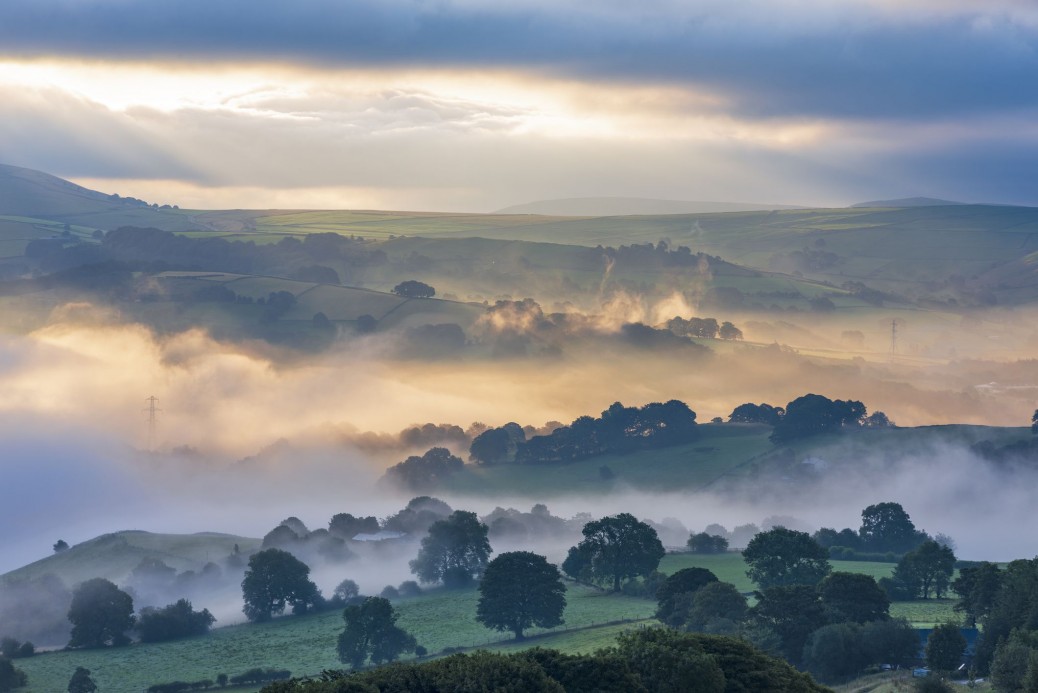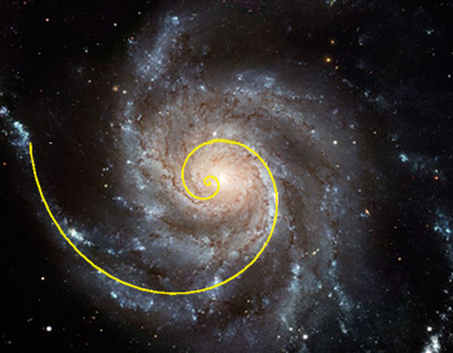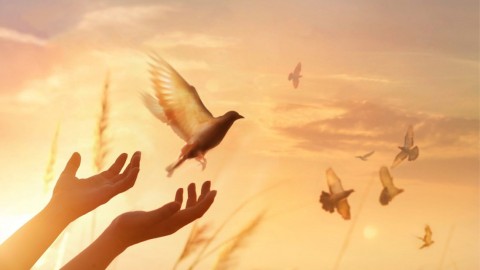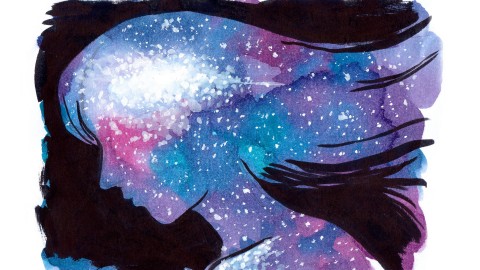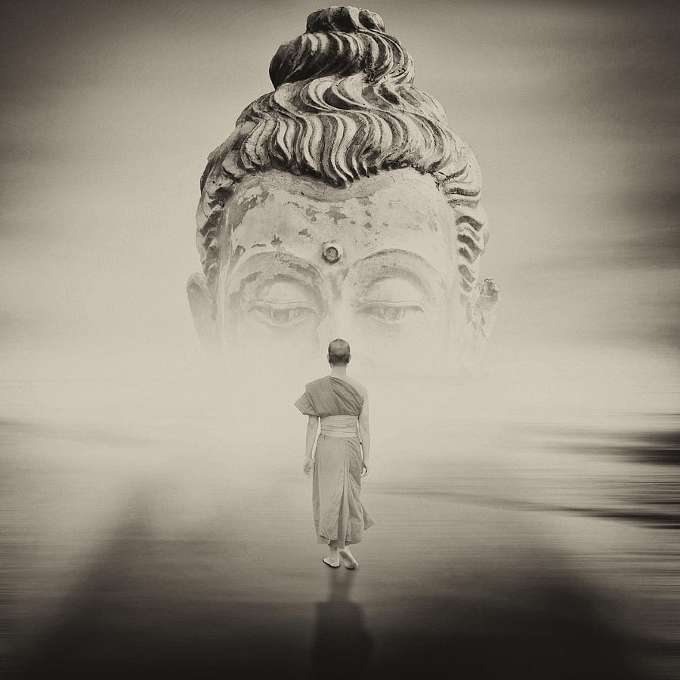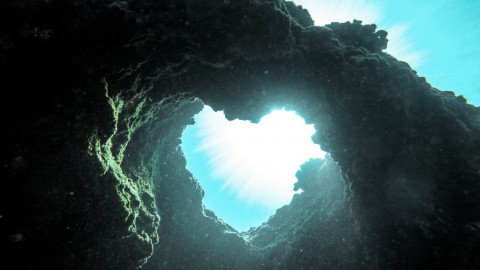WHEN THIS CONTROLLING OF ALL OTHER CONTROLS IS TRANSCENDED, THE SEEDLESS SAMADHI IS ATTAINED, AND WITH IT, FREEDOM FROM LIFE AND DEATH.
This is where all the paths culminate, all the Buddhas meet: Tantra and Yoga, Zen and Hassid, Sufi and Baul – all the paths. Paths may be different – they are – but now this comes, the peak; here paths disappear. WHEN THIS CONTROLLING OF ALL OTHER CONTROLS IS TRANSCENDED… because Patanjali says that it is still a controlled state. Thoughts have disappeared: you can perceive now the existence, but still the perceiver and the perception, the object and the subject… With the body, the knowledge was indirect. Now it is direct, but still the knower is different from the known. The last barrier exists, the division. When even this is dropped, when this control is transcended, and the painter disappears in the painting and the lover disappears in the love, object and subject disappear. There is no knower and no known.
WHEN THIS CONTROLLING OF ALL OTHER CONTROLS IS TRANSCENDED…
This is the last control, the nirvichara samadhi, samadhi where thoughts have ceased. This is the last control. Still you are, not as an ego, but as a self. Still you are separate from the known – just a very transparent veil, but it is there – and if you cling to this you will be born, because the division has not been transcended; you have not attained non-duality yet. The seed of duality is still there, and that seed will sprout into new lives and the wheel of life and death will go on moving.
WHEN THIS CONTROLLING OF ALL OTHER CONTROLS IS TRANSCENDED, THE SEEDLESS SAMADHI IS ATTAINED – THEN YOU ATTAIN THE NIRVICHARA SAMADHI, SEEDLESS – AND WITH IT, FREEDOM FROM LIFE AND DEATH.
Then the wheel stops for you. Then there is no time, no space. Life and death have both disappeared like a dream. How to transcend this last control? – It is the most difficult. To attain nirvichara is very arduous, but nothing compared to the dropping of the last control, because it is very subtle. How to do it? “How” is not relevant at that stage. One has simply to live, watch, enjoy, be loose and natural. This is where Tilopa becomes meaningful.
Because these people like Tilopa are Zen Masters they talk about the goal: loose and natural one lives, doing nothing, doing nothing to transcend the control. Because if you do something, that will again be a control. Your doing will be undoing. Loose and natural – that is the point where the tenth picture of the ten oxherding series becomes meaningful: back again into the world, and not only back again into the world… carrying a bottle of wine. Enjoying, celebrating, being ordinary – that is the meaning. Nothing can be done now. All that could be done you have done. Now you simply become loose and natural and forget everything about yoga, control, sadhana, seeking, search. Forget everything about it, because now, if you do something, then the control will continue, and with control there is no freedom. You have to wait and just being, loose and natural.
Somebody asked Lin Chi, “What you are doing nowadays?” He said, “Chopping wood, carrying water from the well – nothing else.” Chopping wood, carrying water from the well…
Lin Chi must have been at this stage when he answered this. He has come to the last control. Now there remains nothing to be done, so he chops wood. Winter is coming and wood will be needed, and people say it is going to be very cold this winter, so he chops wood; and of course he feels thirsty, so he carries water, waters the garden, vegetables. Absolutely ordinary… no seeking, no search, going nowhere.
This is the state where Zenerin says, “Sitting quietly, sitting silently, doing nothing, spring comes and the grass grows by itself.” Beyond this, words cannot explain. One has to reach; to nirvichara and then wait for the seedless samadhi. It comes on its own, just like the grass grows by itself. Then the last control is transcended, and there is no one who transcends it. It is simply transcended. There is no one who transcends it, because if someone is there to transcend it, again the control is there. So you cannot do anything about it.
That’s why Patanjali simply ends: it is samadhi both.
Here ends the chapter on samadhis – nothing more to say. He doesn’t say anything about how to do it. There is no how, to it. This is the point where Krishnamurti gets very angry, when people ask, “How?” There is no point, no method, no technique, because if any technique is possible here, then the control will remain. The control is transcended, but there is no one who transcends. Remaining loose and natural, chopping wood and carrying water, sitting silently, the spring comes, the grass grows by itself.
So you don’t bother about seedless samadhi. You simply think of nirvichara samadhi, samadhi where thoughts cease. Up to there, search continues. Beyond that is the land of no-search. When you have become nirvichara, then, then only you will understand now what to do. All that could be done you have done.
The last barrier is there. That last barrier is created by your doing. The last barrier is created; it is very transparent. It is as if you are sitting behind a glass wall, very beautiful and pure glass, and you can see everything as clearly as without the wall, but the wall is there, and if you try to cross it you will be hit hard and thrown back.
So nirvichara samadhi is not the last thing, it is the last but one. And that “last but one” is the goal. Beyond that, read Zenerin, Tilopa, Lin Chi; sit silently and let the grass grow by itself. Beyond that you can live in the market, because the market is as beautiful as the monastery. Beyond that you can do whatsoever you feel like doing – you can do your own thing – but not before that. You can relax; the search is over. In that relaxation comes the moment of inner tuning with the cosmos, and the wall disappears. Because it is created by your doing; when you don’t do, it disappears. It is fed by your doing. When you don’t do it, it disappears, and when the doing has disappeared and you have transcended all control, then there is no life and no death, because life is of the doer, death is of the doer.
Now you are no more; you have dissolved. You have dissolved like a piece of salt thrown into the ocean dissolves, and you cannot find where it has gone. Can you find a piece of salt which has dissolved into the ocean? It has become one with the ocean. You can taste the ocean, but you cannot find the piece.
That’s why, when again and again people ask Buddha, “What will happen when a Buddha dies? What happens when a Buddha dies?” – Buddha remains silent; he never answers about it. It was a very persistent question “What happens to a Buddha?” Buddha remains silent because Buddha appears to be to you – for himself, he is no more. Inside, he is no more. Inside, outside have become one; the part and the whole has become one; the devotee and the God have become one; the lover is dissolved into the beloved.
Then what remains? – Love remains: the lover no more, the beloved no more, the knower no more, the known no more – knowing remains. Simple consciousness remains, with no center to it, vast as existence, deep as existence, mysterious as existence. But nothing can be done.
When you come to this point someday – if you seek hard you will come; if you seek hard you will come to nirvichara samadhi – then don’t carry the old habit of doing, then don’t carry the old pattern of doing, then don’t ask “How?” Then simply be loose and natural and let things be. Accept whatsoever happens; celebrate whatsoever happens. Chop wood, carry water, sit silently and let the grass grow.
Tags: Patanjali Yoga Sutra 15.3 Paths Disappear
